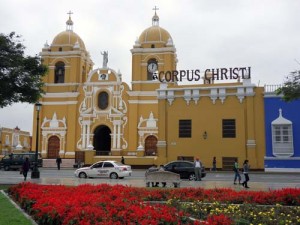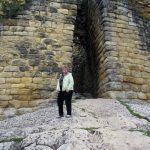After Machu Picchu, the Areas Less Traveled Can Be Most Interesting
When travel in Peru comes up in a conversation among travel gossips, the first question always seems to be, “Have you been to Machu Picchu? Walked the Inca Trail?” Absolutely! Plus, there is so much more to see and do, much of it as breathtaking as Machu Picchu!
Being twice as big as the state of Texas in the USA, Peru varies from desert to jungle climates, from sea level to an endless array of peaks that are more than 6000 meters (19,685 feet). Ancient cultures are as old as those of Egypt are as well preserved, replete with tombs, mummies, and elaborate arts and crafts. Architecture is traditional and modern, color abounds, parks are found everywhere, and the people are friendly and gracious! Accommodations are very comfortable and affordable. The cuisine is exceptionally good and freshly prepared, and reported in Bon Appétit magazine as the best in The Americas. Produce and grains are usually grown locally. It’s a Farmer’s Market at its best!
Head North after Machu Picchu. Peru is blessed with many other unforgettable sites, many equally spellbinding and much less visited. Some travelers are limited to guided tours to a small slice of Peru because they have only a week or so. Take an extra week or more and branch out and travel on your own!
It is very easy to create your own private tour of Peru, far from guided tour land. Just pick up a copy of Lonely Planet Peru or another excellent guidebook and get going! And spend at least two weeks, more if possible. If starting from the USA, the jet lag is minimal since Peru is in the same time zone as New York City.
There is much more to discover. In the next paragraphs, we suggest some places you will want to visit, not only for their character but also for the ancient sites, geographical wonders, photography hotspots, the people, and the cultural “musts” nearby. In the future, we plan to write separate stories about each of these areas so be sure to return to Your Travel Gossip, click the Peru tab, and read everything of interest while planning your trip. In addition, we will write about how to plan easily your own tour of the area.
Trujillo. Not only is this a friendly and lovely Colonial city, it is an excellent place to anchor when traveling to the many ruins, museums, churches, mansions, and picturesque small towns in the region. Western travelers will find cappuccinos, croissants, pizza, essentially the same kinds of cuisine found in an American, Canadian, or European city, PLUS very good ceviche. Even surfboard rentals and surf lessons can be easily found.

Trujillo Cathedral Peru
Surrounding area. From a center in Trujillo, you can easily visit Chan Chan (Chimú culture), including the Tschudi Complex; Huaca (temple) Esmeralda; Huaca Arco Irís; the Temples of the Sun and the Moon; and la Huaca El Brujo / la Huaca Cao Viejo (El Brujo, tomb and museum of the Lady of Cao). The site museums display what archaeologists have unearthed from these enlightened, highly spiritual cultures whose arts and crafts are incredibly beautiful and memorable. There is also a grim element throughout, making us wonder what the ancient people were afraid of, perhaps ‘the devil’ in another guise.
The site and museum of the Lady of Cao, the recently discovered burial site of a high-ranking woman, is a must-see. The partially restored ruins offer a glimpse into highly intelligent people and a sophisticated society that will cause you to question everything

Chiclayo Peru
you learned in your history classes. The beautifully preserved mummy of the Lady is like none other. (We encourage you to buy the DVD at the museum!)
Chiclayo. Only a few hours from Trujillo, Chiclayo offers friendly people, good food, and archeological explorations and museums that will continue to shake up any previous ideas about ancient, ‘primitive’ cultures as you explore ruins on a par with ancient Egypt! Three or four days in Chiclayo are just right because you can do a lot of walking if you so choose.
Surrounding area. Once based in Chiclayo, the first thing you will want to do is ‘get out of town’ and follow the archaeologists. Be sure to visit at least:
- Lambayeque and the Museo Tumbas Reales de Sipán and the Bruning Museum. The Museo Tumbas Reales, a truly incredible new museum, presents the tombs just the way they were discovered, from the top down. The richness of the culture is a must-see. While in Lambayeque, take time to dine at El Cantaro restaurant. One dish in particular, sudado

Lambayeque and the Museo Tumbas Reales de Sipán and the Bruning Museum
de pescado or fish stew, may be the best version of that dish in all of Peru.
- At Sipán, you can view the actual tombs which have been restored to show the burials. We developed a deep admiration for the archaeologists’ ceaseless and long work. Watch for future finds in this area.
- Túcume is another site that can be explored along with the accompanying museum of Ferreñafe. More than 20 pyramids have been discovered, of which three have been extensively explored. There is an excellent opportunity to hike around the area.
The Mercado Modelo in Chiclayo. This is an enormous market where one can find just about anything, including an array of Peruvian crafts, meat and produce, knock-offs of designer jeans and t-shirts, as well as an excellent selection of herbal remedies and a witches’ market. Be sure to bring your camera. While we encountered a few people proclaiming to be healers, including a scowling man who said he was a shaman, we do not recommend doing business with them. Instead, find a reputable healing institute.
We have used several of the local tour agencies and find them reputable. Our English speaking guide was exceptionally good and the prices are reasonable. Once we had taken a tour that included Lambayeque, we learned from our hotel how to get there on a collectivo and we returned several times to re-visit the museums and dine again at El Cantaro.
Chachapoyas. This friendly colonial town, full of excellent restaurants and cafés, is hard to leave! Intending to stay two or three nights and visit the ruins at Kuélap, we spent a week and that was too little time. Fortunate to arrive at the beginning of a regional festival, we enjoyed that for three days and also explored ancient sites and natural wonders. Truly, we ran out of time before we saw all of the places to visit. Do take time to visit the museum on the plaza.

The fortress or citadel of Kuélap
Surrounding area. Whether you want to hike to the base of one of the tallest waterfalls in the world, explore ancient burial sites, search for the spatule-tail hummingbird, view mummies, or walk through ancient cities, this is an ideal location. Places you must consider include:
- One of the older civilizations in Peru (800-1470 AD) inhabited the fortress or citadel of Kuélap, a cliff-perched, cloud-forest retreat built in an area so remote that it proved to be nearly impenetrable. It took a decade for the Incas conquer these people and they succeeded only because of a series of drought years. Definitely on a par with Machu Picchu, the setting reveals a different yet intriguing architecture and culture. Much of Kuélap, including the royal tombs, remain to be explored by archaeologists.
- Karajía, a funerary site where the mummies of dignitaries, along with artifacts, were buried in eight joined sarcophagi, each of which looks like an abstract individual with an exaggerated jaw and brow. Located on a high cliff above a former town, they seem to peer down on one. Built of wood, straw and clay, they almost appear to be lost and lonely figures. Each is eight feet tall and painted with figures.
- Gocta waterfall, which caught world attention in 2005 when it was finally measured at 771 meters (2531 feet), is said to be one of the highest in the world. The falls is most reached from Chachapoyas by taking a tour. A drive out in the van is followed by a long, somewhat difficult hike of about two hours. The area is picturesque, especially the view from the town of Cocachimba. This is a great opportunity to see birds such as the toucan the guide pointed out.
- Revash, funerary buildings near the town of Santo Tomás. We did not visit this site but heard positive reports from a couple who did.
- Leimebamba is the site of a mummy museum and numerous architectural ruins. The local people recommend it but we did not have enough time to visit.
Moyobamba. Lower in altitude than Chachapoyas (and warmer), Moyobamba is the orchid capital of Peru. Residents are outgoing, lodging is excellent, food is top quality, and the town invites one to stay and enjoy. If you love orchids, make a visit to AgroOriente, an orchid grower and seller in Moyobamba. Enjoy a few exquisite, regional meals at La Olla de Barro and pastries at Orquídeas.
Surrounding area. We strongly recommend that, at a minimum, you explore the Waqanki Orchid Center, enjoy a trip into the jungle with the Tingana EcoTourism center, and soak in natural hot springs.
- Waqanki Orchid Center is a reserve for native orchids and has recently built a hummingbird observation area. A guided tour is recommended as there are many species orchids to enjoy, most in their natural habitat and a few transplanted to make them easier to view. For the more adventuresome, there are half-day and whole-day hikes through the area.

Los Baños Termales de San Mateo
- Tingana EcoTourism, booked through Tingana Magic, is a beautiful place to spend a day, exploring the jungle by dugout canoe and getting a view of monkeys, birds, orchids, and more. The meals are excellent and the center is unique in that it encourages farmers in the area to think always of the environment as they plant and cultivate.
- Los Baños Termales de San Mateo are close to Waqanki and can be visited on the same day. There is a good café there. Be sure to try out all the baths are they are different temperatures. The bottoms are natural so take water shoes if your feet are sensitive.
These are only a few of the places to visit in Northern Peru. Treat yourself to something ‘off the beaten path’! Our next article will include tips on planning your trip to Northern Peru.


Comments
After Machu Picchu, the Areas Less Traveled Can Be Most Interesting — No Comments
HTML tags allowed in your comment: <a href="" title=""> <abbr title=""> <acronym title=""> <b> <blockquote cite=""> <cite> <code> <del datetime=""> <em> <i> <q cite=""> <s> <strike> <strong>